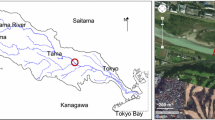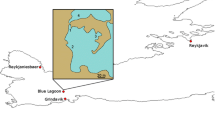Abstract
Ciliates are the largest group of ubiquitous aquatic bacterivorous protists, and many species are easily cultivated. However, only few studies reported prokaryotic communities naturally associated with ciliate cells. Herein, we analyzed the microbiome composition of several strains of Paramecium (Ciliophora) originating from different locations and belonging to two morpho-species by high-throughput sequencing (HTS) of the 16S rRNA gene. Possible reasons of HTS results bias were addressed comparing DNA libraries obtained using different primers and different number of ciliate cells. Microbiomes associated with ciliates and their environments were always significantly different by prokaryotic taxonomic composition and bacterial richness. There were also pronounced differences between Paramecium strains. Interestingly, potentially pathogenic bacteria were revealed in Paramecium microbiomes.





Similar content being viewed by others
References
Azam F, Fenchel T, Field J, Gray JS, Meyer-Reil LA, Thingstad F (1983) The ecological role of water-column microbes in the sea. Mar. Ecol. Prog. Ser. 10:257–263. https://doi.org/10.3354/meps010257
Pernthaler J (2005) Predation on prokaryotes in the water column and its ecological implications. Nat. Rev. Microbiol. 3:537–546. https://doi.org/10.1038/nrmicro1180
Hahn MW, Höfle MG (2001) Grazing of protozoa and its effect on populations of aquatic bacteria. FEMS Microbiol. Ecol. 35:113–121. https://doi.org/10.1111/j.1574-6941.2001.tb00794.x
Jürgens K, Matz C (2002) Predation as a shaping force for the phenotypic and genotypic composition of planktonic bacteria. Antonie Van Leeuwenhoek 81:413:434–413:434. https://doi.org/10.1023/A:1020505204959
Jacquet S, Domaizon I, Chardon C, Personnic S (2013) Are small grazers and/or viruses a structuring factor of the free-living bacterial community in Lake Geneva? Adv Microbiol. 3:233–248. https://doi.org/10.4236/aim.2013.33035
Batani G, Pérez G, Martínez G, Piccini C, Fazi S (2016) Competition and protist predation are important regulators of riverine bacterial community composition and size distribution. J. Freshw. Ecol. 31:609–623. https://doi.org/10.1080/02705060.2016.1209443
Pierce RW, Turner JT (1992) Ecology of planktonic ciliates in marine food webs. Rev. Aquat. Sci. 6:139–181
Beaver JR, Crisman TL (1989) The role of ciliated protozoa in pelagic freshwater ecosystems. Microb. Ecol. 17:111–136. https://doi.org/10.1007/BF02011847
Serra V, Fokin SI, Castelli M, Basuri C, Nitla V, Verni F, Sandeep B, Kalavati C, Petroni G (2016) “Candidatus Gortzia shahrazadis”, a novel endosymbiont of Paramecium multimicronucleatum and a revision of the biogeographical distribution of Holospora-like bacteria. Front. Microbiol. https://doi.org/10.3389/fmicb.2016.01704
Schrallhammer M, Castelli M, Petroni G (2018) Phylogenetic relationships among endosymbiotic R-body producer: Bacteria providing their host the killer trait. Syst. Appl. Microbiol. 41:213–220. https://doi.org/10.1016/j.syapm.2018.01.005
Gong J, Qing Y, Guo X, Warren A (2014) “Candidatus Sonnebornia yantaiensis”, a member of candidate division OD1, as intracellular bacteria of the ciliated protist Paramecium bursaria (Ciliophora, Oligohymenophorea). Syst. Appl. Microbiol. 37:35–41. https://doi.org/10.1016/j.syapm.2013.08.007
Schrallhammer M, Ferrantini F, Vannini C, Galati S, Schweikert M, Görtz HD, Verni F, Petroni G (2013) “Candidatus Megaira polyxenophila” gen. nov., sp. nov.: considerations on evolutionary history, host range and shift of early divergent Rickettsiae. PLoS One 8:e72581. https://doi.org/10.1371/journal.pone.0072581
Watanabe K, Nakao R, Fujishima M, Tachibana M, Shimizu T, Watarai M (2016) Ciliate Paramecium is a natural reservoir of Legionella pneumophila. Sci Rep 6, 24322. https://doi.org/10.1038/srep24322
Peterson TS, Ferguson JA, Watral VG, Mutoji KN, Ennis DG, Kent ML (2013) Paramecium caudatum enhances transmission and infectivity of Mycobacterium marinum and M. chelonae in zebrafish Danio rerio. Dis. Aquat. Org. 106:229–239. https://doi.org/10.3354/dao02649
Pushkareva VI, Ermolaeva SA (2010) Listeria monocytogenes virulence factor Listeriolysin O favors bacterial growth in co-culture with the ciliate Tetrahymena pyriformis, causes protozoan encystment and promotes bacterial survival inside cysts. BMC Microbiol 10:26. https://doi.org/10.1186/1471-2180-10-26
King CH, Shotts EB, Wooley RE, Porter KG (1988) Survival of coliforms and bacterial pathogens within protozoa during chlorination. Appl. Environ. Microbiol. 54:3023–3033
Erken M, Lutz C, McDougald D (2013) The rise of pathogens: predation as a factor driving the evolution of human pathogens in the environment. Microb. Ecol. 65:860–868. https://doi.org/10.1007/s00248-013-0189-0
Sun S, Noorian P, McDougald D (2018) Dual role of mechanisms involved in resistance to predation by protozoa and virulence to humans. Front. Microbiol. 9:1017. https://doi.org/10.3389/fmicb.2018.01017
Konstantinidis KT, Rosselló-Móra R, Amann R (2017) Uncultivated microbes in need of their own taxonomy. ISME J. 11:2399–2406. https://doi.org/10.1038/ismej.2017.113
Parte AC (2014) LPSN – list of prokaryotic names with standing in nomenclature. Nucleic Acids Res. 42:613–616. https://doi.org/10.1093/nar/gkt1111
Kircher M, Kelso J (2010) High-throughput DNA sequencing—concepts and limitations. Bioessays 32:524–536. https://doi.org/10.1002/bies.200900181
Escobar-Zepeda A, De León AVP, Sanchez-Flores A (2015) The road to metagenomics: from microbiology to DNA sequencing technologies and bioinformatics. Front Genet 6:348. https://doi.org/10.3389/fgene.2015.00348
Irbis C, Ushida K (2004) Detection of methanogens and proteobacteria from a single cell of rumen ciliate protozoa. J. Gen. Appl. Microbiol. 50:203–212. https://doi.org/10.2323/jgam.50.203
Pucciarelli S, Devaraj RR, Mancini A, Ballarini P, Castelli M, Schrallhammer M, Petroni G, Miceli C (2015) Microbial consortium associated with the Antarctic marine ciliate Euplotes focardii: an investigation from genomic sequences. Microb. Ecol. 70:484–497. https://doi.org/10.1007/s00248-015-0568-9
Gong J, Qing Y, Zou S, Fu R, Su L, Zhang X, Zhang Q (2016) Protist-bacteria associations: Gammaproteobacteria and Alphaproteobacteria are prevalent as digestion-resistant bacteria in ciliated protozoa. Front. Microbiol. 7:498. https://doi.org/10.3389/fmicb.2016.00498
Omar A, Zhang Q, Zou S, Gong J (2017) Morphology and phylogeny of the soil ciliate Metopus yantaiensis n. sp. (Ciliophora, Metopida), with identification of the intracellular bacteria. J. Eukaryot. Microbiol. 64:792–805. https://doi.org/10.1111/jeu.12411
Park T, Yu Z (2018) Do ruminal ciliates select their preys and prokaryotic symbionts? Front. Microbiol. 9:1710. https://doi.org/10.3389/fmicb.2018.01710
Rossi A, Bellone A, Fokin SI, Boscaro V, Vannini C (2018) Detecting associations between ciliated Protists and prokaryotes with culture-independent single-cell microbiomics: a proof-of-concept study. Microb. Ecol. https://doi.org/10.1007/s00248-018-1279-9
Shapiro E, Biezuner T, Linnarsson S (2013) Single-cell sequencing-based technologies will revolutionize whole-organism science. Nat. Rev. Genet. 14:618–630. https://doi.org/10.1038/nrg3542
Yoon HS, Price DC, Stepanauskas R, Rajah VD, Sieracki ME, Wilson WH, Yang EC, Duffy S, Bhattacharya D (2011) Single-cell genomics reveals organismal interactions in uncultivated marine protists. Science 332:714–717. https://doi.org/10.1126/science.1203163
Martinez-Garcia M, Brazel D, Poulton NJ, Swan BK, Gomez ML, Masland D, Sieracki ME, Stepanauskas R (2012) Unveiling in situ interactions between marine protists and bacteria through single cell sequencing. ISME J 6:703–707. https://doi.org/10.1038/ismej.2011.126
Hugerth LW, Andersson AF (2017) Analysing microbial community composition through amplicon sequencing: from sampling to hypothesis testing. Front. Microbiol. 8:1561. https://doi.org/10.3389/fmicb.2017.01561
Kodama Y, Fujishima M (2016) Paramecium as a model organism for studies on primary and secondary endosymbioses. Biocommunication of Ciliates: 277–304. https://doi.org/10.1007/978-3-319-32211-7_16
Klindworth A, Pruesse E, Schweer T, Jörg Peplies, Quast C, Horn M, Glöckner F (2013) Evaluation of general 16S ribosomal RNA gene PCR primers for classical and next-generation sequencing-based diversity studies. Nucleic Acids Res 41:e1. https://doi.org/10.1093/nar/gks808
Zhou J, Wu L, Deng Y, Zhi X, Jiang YH, Tu Q, Xie J, Van Nostrand JD, He Z, Yang Y (2011) Reproducibility and quantitation of amplicon sequencing-based detection. ISME J 5:1303–1313. https://doi.org/10.1038/ismej.2011.11
Wen C, Wu L, Qin Y, Van Nostrand JD, Ning D, Sun B, Xue K, Liu F, Deng Y, Liang Y, Zhou J (2017) Evaluation of the reproducibility of amplicon sequencing with Illumina MiSeq platform. PLoS One 12:e0176716. https://doi.org/10.1371/journal.pone.0176716
Yang B, Wang Y, Qian P-Y (2016) Sensitivity and correlation of hypervariable regions in 16S rRNA genes in phylogenetic analysis. BMC Bioinformatics 17:135. https://doi.org/10.1186/s12859-016-0992-y
Almeida A, Mitchell AL, Tarkowska A, Finn RD (2018) Benchmarking taxonomic assignments based on 16S rRNA gene profiling of the microbiota from commonly sampled environments. Gigascience 7:giy054. https://doi.org/10.1093/gigascience/giy054
Zhang J, Kobert K, Flouri T, Stamatakis A (2014) PEAR: a fast and accurate Illumina paired-end reAd mergeR. Bioinformatics 30:614–620. https://doi.org/10.1093/bioinformatics/btt593
Edgar RC (2013) UPARSE: highly accurate OTU sequences from microbial amplicon reads. Nat. Methods 10:996–998. https://doi.org/10.1038/nmeth.2604
Konstantinidis KT, Tiedje JM (2005) Genomic insights that advance the species definition for prokaryotes. Proc. Natl. Acad. Sci. 102:2567–2572. https://doi.org/10.1073/pnas.0409727102
Kim M, Oh H-S, Park S-C, Chun J (2014) Towards a taxonomic coherence between average nucleotide identity and 16S rRNA gene sequence similarity for species demarcation of prokaryotes. Int. J. Syst. Evol. Microbiol. 64:346–351. https://doi.org/10.1099/ijs.0.059774-0
Edgar RC, Haas BJ, Clemente JC, Quince C, Knight R (2011) UCHIME improves sensitivity and speed of chimera detection. Bioinformatics 27:2194–2200. https://doi.org/10.1093/bioinformatics/btr381
Cole JR, Wang Q, Fish JA, Chai B, McGarrell DM, Sun Y, Brown CT, Porras-Alfaro A, Kuske CR, Tiedje JM (2014) Ribosomal Database Project: data and tools for high throughput rRNA analysis. Nucleic Acids Res 42:D633–D642. https://doi.org/10.1093/nar/gkt1244
Salter SJ, Cox MJ, Turek EM, Calus ST, Cookson WO, Moffatt MF, Turner P, Parkhill J, Loman NJ, Walker AW (2014) Reagent and laboratory contamination can critically impact sequence-based microbiome analyses. BMC Biol 12:87. https://doi.org/10.1186/s12915-014-0087-z
Delafont V, Bouchon D, Héchard Y, Moulin L (2016) Environmental factors shaping cultured free-living amoebae and their associated bacterial community within drinking water network. Water Res. 100:382–392. https://doi.org/10.1016/j.watres.2016.05.044
Rajendhran J, Gunasekaran P (2011) Microbial phylogeny and diversity: small subunit ribosomal RNA sequence analysis and beyond. Microbiol. Res. 166:99–110. https://doi.org/10.1016/j.micres.2010.02.003
Newton RJ, Jones SE, Eiler A, McMahon KD, Bertilsson S (2011) A guide to the natural history of freshwater lake bacteria. Microbiol. Mol. Biol. Rev. 75:14–49. https://doi.org/10.1128/MMBR.00028-10
Castelli M, Sassera D, Petroni G (2016) Biodiversity of “non-model” Rickettsiales and their association with aquatic organisms. Rickettsiales: Biology, Molecular biology, Epidemiology, and Vaccine development: 59–91, Springer. https://doi.org/10.1007/978-3-319-46859-4_3
Selivanova EA, Poshvina DV, Khlopko YA, Gogoleva NE, Plotnikov AO (2018) Diversity of prokaryotes in planktonic communities of saline Sol-Iletsk lakes (Orenburg oblast, Russia). Microbiology 87:569–582. https://doi.org/10.1134/S0026261718040161
García-Bayona L, Comstock LE (2018) Bacterial antagonism in host-associated microbial communities. Science 361:eaat2456. https://doi.org/10.1126/science.aat2456
Thomas V, McDonnell G (2007) Relationship between mycobacteria and amoebae: ecological and epidemiological concerns. Lett. Appl. Microbiol. 45:349–357. https://doi.org/10.1111/j.1472-765X.2007.02206.x
Delafont V, Mougari F, Cambau E, Joyeux M, Bouchon D, Héchard Y, Moulin L (2014) First evidence of amoebae-mycobacteria association in drinking water network. Environ Sci Technol 48:11872–11882. https://doi.org/10.1021/es5036255
Denoncourt AM, Paquet VE, Charette SJ (2017) Packaging of Mycobacterium smegmatis bacteria into fecal pellets by the ciliate Tetrahymena pyriformis. FEMS Microbiol Lett 364:fnx237. https://doi.org/10.1093/femsle/fnx237
Barker J, Brown MRW (1994) Trojan horses of the microbial world: Protozoa and the survival of bacterial pathogens in the environment. Microbiology 140:1253–1259. https://doi.org/10.1099/00221287-140-6-1253
Funding
This study was funded by the Russian Science Foundation (grant number 16-14-10157), except the pilot analysis of the P. aurelia samples, which was supported by the Russian Foundation for Basic Research (grant number 14-04-01796).
Author information
Authors and Affiliations
Corresponding author
Ethics declarations
Conflict of Interest
The authors declare that they have no conflict of interest.
Electronic Supplementary Material
ESM 1
(XLSX 98 kb)
Rights and permissions
About this article
Cite this article
Plotnikov, A.O., Balkin, A.S., Gogoleva, N.E. et al. High-Throughput Sequencing of the 16S rRNA Gene as a Survey to Analyze the Microbiomes of Free-Living Ciliates Paramecium. Microb Ecol 78, 286–298 (2019). https://doi.org/10.1007/s00248-019-01321-x
Received:
Accepted:
Published:
Issue Date:
DOI: https://doi.org/10.1007/s00248-019-01321-x




